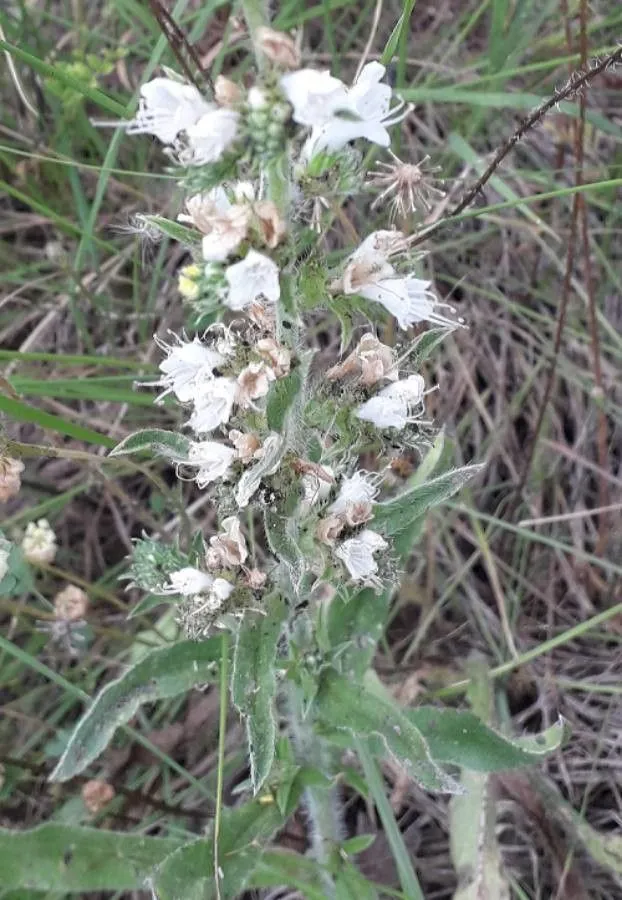
Author: L.
Bibliography: Sp. Pl.: 139 (1753)
Year: 1753
Status: accepted
Rank: species
Genus: Echium
Vegetable: Unknown
Observations: EC. & S. Europe to Afghanistan
Pale-bugloss, known by its scientific name Echium italicum, is a captivating plant that belongs to the Boraginaceae family. First described in the seminal work “Species Plantarum” in 1753 by the renowned botanist Carl Linnaeus, this species has a diverse geographic range. It can be found across various regions in Europe, extending its presence from Eastern and Southern Europe all the way to Afghanistan.
Echium italicum is notable for its striking pale-blue flowers, which add a delicate yet vibrant touch to the landscapes it inhabits. This plant is typically biennial, meaning it completes its life cycle over two years. In the first year, it forms a rosette of leaves close to the ground, while in the second year, it sends up flowering stalks that can reach heights of up to one meter.
The foliage of Pale-bugloss is characterized by rough, hairy leaves that are lanceolate in shape. These leaves are not only visually distinct but also serve an adaptive purpose, protecting the plant from herbivores and reducing water loss in the arid climates it often thrives in.
Echium italicum’s flowers are assembled in elongated clusters that bloom progressively from the bottom upward. Each flower has five petals fused into a tube, showcasing a classic feature of the Boraginaceae family. The pale-blue hue of the flowers can sometimes exhibit a subtle lavender tint, making them particularly appealing to pollinators such as bees and butterflies.
A hardy plant, Pale-bugloss is well-suited to dry, rocky soils and can often be found in open fields, along roadsides, and in disturbed areas. Its resilience and adaptability make it a splendid addition to drought-tolerant gardens and naturalized settings.
Overall, Pale-bugloss (Echium italicum) is not only an ornamental plant but also a valuable species in understanding plant ecology across its expansive range. Its ability to thrive in varied environments highlights its evolutionary success and the intricate beauty of the natural world.
Deu: hoher natternkopf, hoher naternkopf
Eng: italian bugloss, italian viper’s bugloss, italian-bugloss, lady campbell-weed, pale-bugloss, yellow-bugloss, pale bugloss
Dan: italiensk slangehoved
Swe: italiensk snokört
En: Pale-bugloss, Lady Campbell-weed, Italian-bugloss, Yellow-bugloss, Italian viper’s bugloss, Italian bugloss, Pale Bugloss, Italian Vipersbugloss
Ar: زهرة الأفعى الإيطالية
Bg: Италианско усойниче
Da: Italiensk slangehoved
Fi: Italianneidonkieli
Fr: Vipérine d’Italie, Échium d’Italie, Vipérine des Albères
De: Hoher Naternkopf, Italienischer Natternkopf, Hoher Natternkopf, Italienischer Natterkopf
Hu: Magas kígyószisz
It: Viperina maggiore
Fa: گل گاوزبان ایتالیایی
Pt-br: Borrago-italiano
Sv: Italiensk snokört
Taken Jun 17, 2018 by Juan Carlos Gallego (cc-by-sa)
Taken Nov 26, 2018 by Toñi Antonio (cc-by-sa)
Taken Jul 2, 2019 by houseofleaves (cc-by-sa)
Taken Jun 26, 2018 by Cruz Fer (cc-by-sa)
Taken Jun 26, 2018 by Cruz Fer (cc-by-sa)
Taken Apr 19, 2013 by Tela Botanica − Yoan MARTIN (cc-by-sa)
Taken Oct 23, 2021 by Lugifa Lugifa (cc-by-sa)
Taken Jun 16, 2019 by Llandrich anna (cc-by-sa)
Taken Jun 22, 2021 by juan llanos (cc-by-sa)
Taken Jun 26, 2018 by Cruz Fer (cc-by-sa)
© copyright of the Board of Trustees of the Royal Botanic Gardens, Kew.
© copyright of the Board of Trustees of the Royal Botanic Gardens, Kew.
Taken May 22, 2016 by Tela Botanica − Genevieve BOTTI (cc-by-sa)
Taken Jun 19, 2021 by Denis Bastianelli (cc-by-sa)
Taken Jul 6, 2022 by Andrzej Konstantynowicz (cc-by-sa)
Taken Apr 29, 2022 by Lugifa Lugifa (cc-by-sa)
Taken Jun 22, 2021 by juan llanos (cc-by-sa)
Taken Jul 27, 2019 by mrhaxx (cc-by-sa)
Taken Jan 18, 2020 by Seyf Dean (cc-by-sa)
Taken Jun 26, 2018 by Cruz Fer (cc-by-sa)
Taken Jun 26, 2018 by Cruz Fer (cc-by-sa)
Taken Jan 29, 2022 by Fuentetaja Guardeño (cc-by-sa)
Taken Dec 18, 2021 by Yvann Robinet (cc-by-sa)
Taken Dec 18, 2021 by Yvann Robinet (cc-by-sa)
Taken Nov 29, 2021 by Nathanaël Rivier (cc-by-sa)
Taken Sep 17, 2014 by Tela Botanica − Pierre BIRGET (cc-by-sa)
Taken Oct 14, 2021 by vincent baglin (cc-by-sa)
Taken Aug 15, 2019 by Photoflora – Benoit BOCK (©)
Taken Jun 3, 2014 by Tela Botanica − Geneviève Botti (cc-by-sa)
Taken Jun 3, 2014 by Tela Botanica − Geneviève Botti (cc-by-sa)
Taken Apr 28, 2013 by Tela Botanica − Geneviève Botti (cc-by-sa)
Taken Jun 20, 2014 by Tela Botanica − Patrice GIRAUDEAU (cc-by-sa)
Family: Myrtaceae Author: (F.Muell.) K.D.Hill & L.A.S.Johnson Bibliography: Telopea 6: 402 (1995) Year: 1995 Status:…
Family: Rubiaceae Author: Pierre ex A.Froehner Bibliography: Notizbl. Bot. Gart. Berlin-Dahlem 1: 237 (1897) Year:…
Family: Sapindaceae Author: Koidz. Bibliography: J. Coll. Sci. Imp. Univ. Tokyo 32(1): 38 (1911) Year:…
Family: Asteraceae Author: A.Gray Bibliography: Pacif. Railr. Rep.: 107 (1857) Year: 1857 Status: accepted Rank:…
Family: Fabaceae Author: Medik. Bibliography: Vorles. Churpfälz. Phys.-Ökon. Ges. 2: 398 (1787) Year: 1787 Status:…
Family: Aspleniaceae Author: (Cav.) Alston Bibliography: Bull. Misc. Inform. Kew 1932: 309 (1932) Year: 1932…